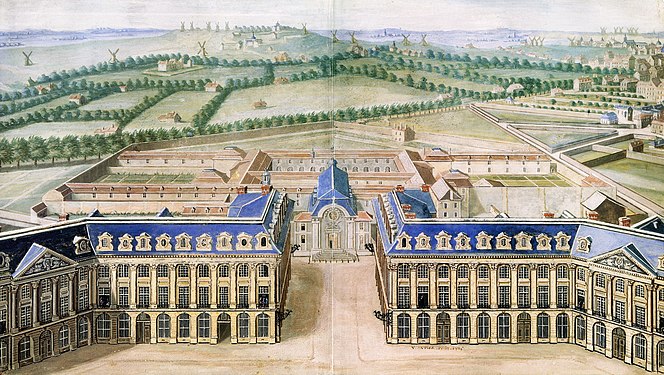Place Vendôme

ThePlace Vendôme(French pronunciation:[plasvɑ̃dom]), earlier known as thePlace Louis-le-Grand,and also as thePlace Internationale,is a square in the1st arrondissement of Paris,France,located to the north of theTuileries Gardensand east of theÉglise de la Madeleine.It is the starting point of theRue de la Paix.Its regular architecture byJules Hardouin-Mansartand pedimented screens canted across the corners give the rectangular Place Vendôme the aspect of an octagon. The original Vendôme Column at the centre of the square was erected byNapoleon Ito commemorate theBattle of Austerlitz;it was torn down on 16 May 1871, by decree of theParis Commune,but subsequently re-erected and remains a prominent feature on the square today.
History[edit]
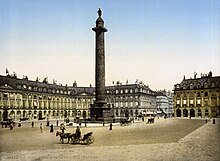
The Place Vendôme was begun in 1698 as a monument to the glory of the armies ofLouis XIV, the Grand Monarque,[1]and called the Place des Conquêtes, to be renamed the Place Louis le Grand, when the conquests proved temporary. An over life-sizeequestrian statueof the king byFrançois Girardon(1699) was donated by the city authorities and set up in its centre. It is believed to be the first large modern equestrian statue to be cast in a single piece. It was destroyed in theFrench Revolution;however, there is a small version in theLouvre.[2]This led to the popular joke that whileHenri IVdwelled among the people by thePont Neuf,andLouis XIIIamong the aristocrats of thePlace des Vosges,Louis XIVpreferred the company of thetax farmersin the Place Vendôme; each reflecting the group they had favoured in life.[3]
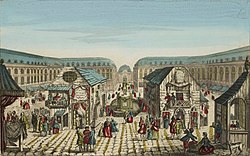
The site of the square was formerly thehôtelofCésar de Bourbon, Duke of Vendôme,the illegitimate son ofHenry IVand his mistressGabrielle d'Estrées.Hardouin-Mansart bought the building and its gardens, with the idea of converting it into building lots as a profitable speculation. The plan did not materialize, and Louis XIV's Minister of Finance,Louvois,purchased the piece of ground, with the object of building a square, modelled on the successfulPlace des Vosgesof the previous century. Louvois came into financial difficulties and nothing came of his project, either. After his death, the king purchased the plot and commissioned Hardouin-Mansart to design a house-front that the buyers of plots round the square would agree to adhere to. When the state finances ran low, the financierJohn Lawtook on the project, built himself a residence behind one of the façades, and the square was complete by 1720, just as his paper-moneyMississippi bubbleburst. Law suffered a major blow when he was forced to pay back taxes amounting to some tens of millions of dollars. With no way to pay such an amount, he was forced to sell the property he owned on the square. The buyers were members of the exiledCondé branch of the House of Bourbonwho later returned to the country to reclaim their land in the town ofVendômeitself. Between 1720 and 1797, they acquired much of the square, including a freehold to parts of the site on which theHôtel Ritz Parisnow stands and in which they still maintain apartments. Their intention to restore a family palace on the site was dependent on the possible intentions of the adjacent Justice Ministry to expand its premises.
TheFoire Saint-Ovidesettled in 1764 on the Place until 1771.
When Franceestablished diplomatic relationswith the short-livedRepublic of Texas,the Texan legation was housed at Hôtel Bataille de Francès in 1 Place Vendôme.[4]
- Two bird's-eye views of the Place Louis-le-Grand in 1705
-
View to the north with the Couvent des Capucines in the background andMontmartrein the distance
-
View to the west with the domedChurch of the Daughters of the Assumptionvisible on the south side of the Rue Saint-Honoré
The Vendôme Column[edit]

Creation[edit]

The original column was started in 1806 atNapoleon's direction and completed in 1810.[5]It was modelled afterTrajan's Column,to celebrate thevictory of Austerlitz;its veneer of 425 spiralling bas-relief bronze plates was made out of cannon taken from the combined armies of Europe, according to his propaganda. (The usual figure given is hugely exaggerated: 180 cannon were actually captured at Austerlitz.[6]) These plates were designed by the sculptorPierre-Nolasque Bergeretand executed by a team of about 30 sculptors includingJean-Joseph Foucou,Louis-Simon Boizot,François Joseph Bosio,Lorenzo Bartolini,Claude Ramey,François Rude,Corbet,Clodion,Julie Charpentier,andHenri-Joseph Ruxthiel.A statue of Napoleon byAntoine-Denis Chaudetwas placed on top of the column. Napoleon is depicted dressed in Roman attire, bare-headed, crowned with laurels, holding a sword in his right hand and a globe surmounted with a statue ofVictory(as inNapoleon as Mars the Peacemaker) in his left hand.[7]
In 1816, taking advantage of the Allied occupying force, a mob of men and horses had attached a cable to the neck of the statue of Napoleon atop the column, but it had refused to budge – one woman quipped: "If the Emperor is as solid on his throne as this statue is on its column, he's nowhere near descending the throne".[citation needed]After theBourbon Restorationthe statue, though not the column, was pulled down and melted down to provide the bronze for the recast equestrian statue ofHenry IVon thePont Neuf(as was bronze from sculptures on theColumn of the Grande Arméeat Boulogne-sur-Mer), though the statuette of Victory is still to be seen in the salon Napoléon of theHôtel des Monnaies(which also contains a model of the column and a likeness of Napoleon's face copied from hisdeath mask).[citation needed]A replacement statue of Napoléon in modern dress (a bicorn hat, boots and aredingote), however, was erected byLouis-Philippe,and a better, more augustly classicizing one byLouis-Napoléon (later Napoléon III).[8]
Demolition during the Paris Commune[edit]
Regardless of the political assessment ofKarl Marx's theory, one thing is certain: he predicted the collapse of the Vendôme Column long before it happened. This prediction was given by him in the political pamphletLe 18 Brumaire de Louis Bonaparteof 1852. This pamphlet, sharply critical of the political figure of Napoleon III, ends with the words: "But if the Imperial mantle finally falls on the shoulders of Louis Bonaparte, the bronze statue of Napoleon will fall from the height of the Vendôme Column".[9]
During the events in the run-up to the founding of the Commune, the 22 of March 1871 saw disturbances outside the National Guard when demonstrators holding banners declaring them to be "Friends of Peace" were blocked from entering the Place Vendôme by guardsmen who, after being fired on, opened fire on the crowd. At least 12 people were killed and many wounded.[10]




During theParis Communein 1871, the painterGustave Courbet,president of the Federation of Artists and elected member of the Commune,[11]who had previously expressed his dismay that this monument to war was located on the Rue de la Paix, proposed that the column be disassembled and preserved at theHôtel des Invalides.Courbet argued that:
In as much as the Vendôme Column is a monument devoid of all artistic value, tending to perpetuate by its expression the ideas of war and conquest of the past imperial dynasty, which are reproved by a republican nation's sentiment, citizen Courbet expresses the wish that the National Defense government will authorise him to disassemble this column.[12]
His project as proposed was not adopted, though on 12 April 1871 legislation was passed authorizing the dismantling of the imperial symbol. When the column was taken down on 16 May its bronze plates were preserved. After employing a series of ropes and quarry workers, observers saw that the statue...
...fell over on the heap of sand prepared for it, with a mighty crash. There was no concussion on the ground, the column broke up almost before it reached its bed, and lay on the ground, a huge mass of ruin. An immense dust and smoke from the stones and crumpled clay rose up and an instant after a crowd of men, National Guards, Communards, and a sight-seeing Englishman flew upon it, and commenced to get bits of it as remembrance, but the excitement was so intense that people moved about as in a dream.[13]
Immediately following the destruction of the column and in repudiation of its perceived glorification of national chauvinism and bellicosity, the Place Vendôme was renamed the Place Internationale in celebration of the Communards' promotion of international fraternity.[14]
After the Paris Commune[edit]
After the suppression of the Paris Commune byAdolphe Thiers,the decision was made to rebuild the column with the statue of Napoléon restored at its apex. For his role in the Commune, Courbet was condemned to pay the costs of rebuilding the monument, estimated at 323,000francs,in yearly installments of 10,000 francs. Unable to pay, Courbet went into self-imposed exile in Switzerland, the French government seized and sold the artist's paintings for a minor amount, and Courbet died in exile in December 1877.[15][16]In 1874 meanwhile, the column was re-erected at the center of the Place Vendôme with a copy of the original statue on top.[citation needed]An inner staircase leading to the top is no longer open to the public.[citation needed]
Features[edit]
At the centre of the square's long sides, Hardouin-Mansart's range ofCorinthian pilastersbreaks forward under a pediment, to create palace-like fronts. The arcading of the formally rusticated ground floors does not provide an arcaded passageway as at the Place des Vosges. The architectural linking of the windows from one floor to the next, and the increasing arch of their windowheads, provide an upward spring to the horizontals formed by ranks of windows. Originally the square was accessible by a single street and preserved an aristocratic quiet, except when the annual fair was held there. Then Napoléon opened theRue de la Paix,and the 19th century filled the Place Vendôme with traffic. It was only after the opening in 1875 of thePalais Garnieron the other side of the Rue de la Paix that the centre of the Parisian fashionable life started gravitating around the Rue de la Paix and the Place Vendôme.[17]
Hôtels particuliers[edit]
Hôtels particulierson the Place Vendôme:
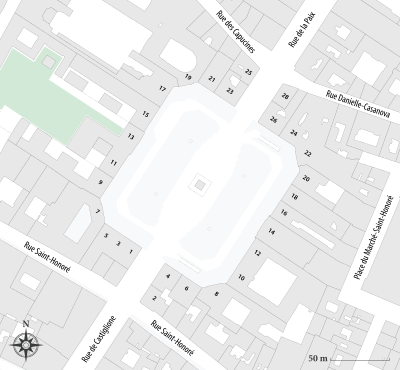 |
|
In popular culture[edit]
The Place Vendôme has been renowned for its fashionable and deluxe hotels such as theRitz.Many famous dress designers have had their salons in the square. The only two remaining are the shirtmakerCharvet,at number 28, whose store has been on the Place Vendôme since 1877,[18]and the couturierChéruit,at number 21, reestablished in 2008.[19]Since 1718, theMinistry of Justice,also known as the "Chancellerie", is located at the Hotel de Bourvallais located at numbers 11 and 13. Right on the other side of the Place Vendôme, number 14 houses the Paris office ofJP Morgan,the investment bank, and number 20 the office ofArdian(formerly AXA Private Equity).
After his death in 1990, American artistKeith Haringwas cremated and his ashes were sprinkled out on a hillside nearKutztown,except for one handful, thatYoko Onobrought to the Place Vendôme because she believed the spirit of Haring had told her to.
In the 1920s, American architect,Alonzo C. Webbworked making advertisements and designs in English for some of the fashionable houses along the Place Vendôme.
Place Vendômewas a 1998moviebyNicole GarciastarringCatherine Deneuve.
Mark Twainmade reference to the Vendôme Column in his speechSome Thoughts on the Science of Onanism.
The Place Vendôme is the setting for the theft of the Black Pearl in Episode 1 of Season 3 of theNetflixseriesLupin.
-
Panoramic view of the Place Vendôme
Notable residents[edit]
- Claude Dupin,(1686–1769), the financier and contracted tax-collector (fermier-général), at 10, Place Vendôme.
- Augustin Blondel de Gagny(1695—1776).
- Abel-François Poisson, marquis de Marigny,(1727–1781), the brother ofMadame de Pompadour,at 8, Place Vendôme.
- Franz Mesmer,(1734–1815), the German physician and discoverer ofanimal magnetism,at 16, Place Vendôme.
- Anne Lister(1791-1840), the English landowner and diarist, stayed at 24, Place Vendôme, a guesthouse run by M. and Mme de Boyve in 1824-25.[20]This is where she met and carried on an affair with Maria Barlow.[21]
- Frédéric Chopin,(1810–1849), thePolishcomposer,at 12, Place Vendôme, where he died.
- Virginia Oldoini, Countess di Castiglione(1837–1899), the former mistress ofNapoleon III,lived in seclusion from the 1870s until the 1890s at 26, Place Vendôme, aboveBoucheron.
- Samuel Jean de Pozzi,(1846–1918), the surgeon and gynaecologist, at 10, Place Vendôme.
- Coco Chanel,(1883–1971), the fashion designer, at 15, Place Vendôme, (theHôtel Ritz Paris).
- Prince Jefri Bolkiah,at 3-5, Place Vendôme.
Metro station[edit]
The Place Vendôme is:
| Located near theMétro stations:Opéra,Pyramides,MadeleineandTuileries. |
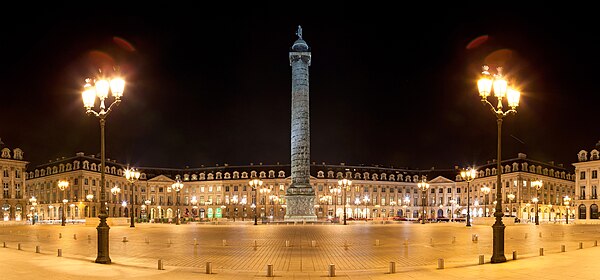
See also[edit]
References[edit]
- ^"Louis XIV (Le Grand Monarque)"in M. S. Fitzgerald,The Kings of Europe, Past and Present, and Their Families(London, Longman, Green, and Co., 1879).
- ^Louvre picture
- ^Walks in Paris
- ^"Where to find the Texas Embassy in Paris?".11 February 2017.
- ^"Place Vendôme".Unveiling the Timeless Charm of Place Vendôme.
- ^Chandler, David G.(1995).The Campaigns of Napoleon.New York:Simon & Schuster.p. 320.ISBN9781439131039.
- ^Ambroise Tardieu,La Colonne de la Grande Armée d'Austerlitz ou de la Victoire, monument triomphal élevé à la gloire de la grande armée par Napoléon.Paris, 1822,p. 4 (list of sculptors)andplate 36 (statue of Napoleon).
- ^King, Ross (2006).The Judgement of Paris.New York: Walker and Company. pp.303–305.ISBN9780802715166.
- ^Маркс К., Энгельс Ф. Полное собрание сочиений. Москва. 2-е изд., т. 8, с. 217/Marx, K., and Engels, F. Complete collection of compositions. Moscow. 2nd ed., vol. 8, p. 217
- ^Milner, John (2000).Art, War and Revolution in France, 1870-1871: Myth, Reportage and Reality.New Haven and London: Yale University Press. pp. 143–145.ISBN0300084072.Retrieved1 May2018.
- ^Linda Nochlin. 2007. 'Courbet, The Commune and the Visual Arts.' inCourbet.New York: Thames & Hudson. pp. 84–94.
- ^"Attendu que la colonne Vendôme est un monument dénué de toute valeur artistique, tendant à perpétuer par son expression les idées de guerre et de conquête qui étaient dans la dynastie impériale, mais que réprouve le sentiment d’une nation républicaine, [le citoyen Courbet] émet le vœu que le gouvernement de la Défense nationale veuille bien l’autoriser à déboulonner cette colonne.[1],
- ^Horne, Alistair(1965). "Chapter 23: 'Floreal 79'".The Fall of Paris: The Siege and the Commune 1870-1.St. Martin's Press, New York. p. 351.
- ^Ross, Kristin (2016).Communal Luxury: The Political Imaginary of the Paris Commune.London:Verso Books.p. 23.ISBN9781784780548.
- ^Linda Nochlin. 2007. 'The De-Politicization of Gustave Courbet: Transformation and Rehabilitation under the Third Republic.' inCourbet.New York: Thames & Hudson. pp. 116–127.
- ^King, Ross (2006).The Judgement of Paris.New York: Walker and Company. pp.349–350.ISBN9780802715166.
- ^Perrot, Philippe (1996).Fashioning the Bourgeoisie: A History of Clothing in the Nineteenth Century.Princeton:Princeton University Press.p. 41.ISBN0-691-00081-6.
- ^Sarmant, Thierry; Luce Gaume (2003).La Place Vendôme: art, pouvoir et fortune(in French). Paris: Action artistique de la ville de Paris. p. 250.
- ^Chéruit, 21 Place Vendôme, Paris,website
- ^"Christmas in Paris with Anne Lister |".www.annelister.co.uk.19 December 2017.Retrieved2021-03-29.
- ^Orr, Dannielle (2006).A sojourn in Paris 1824-25: sex and sociability in the manuscript writings of Anne Lister (1791-1840)(phd thesis). Murdoch University.
External links[edit]
- Place Vendôme and its history
- Comité VendômeArchived2008-07-25 at theWayback Machine(in French)

